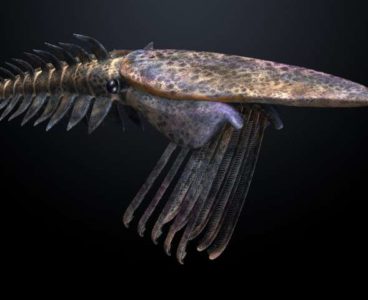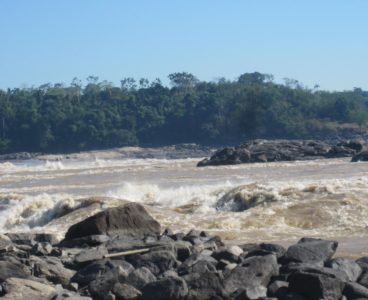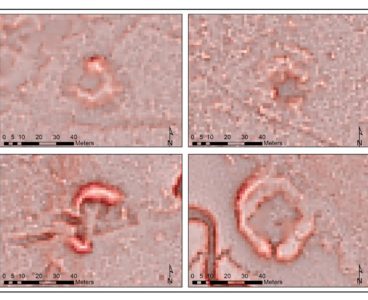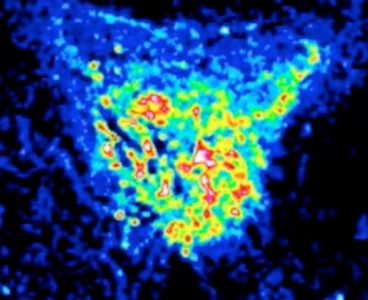Scientists from The Australian National University (ANU) and overseas have discovered molecules of fat in an ancient fossil to reveal the earliest confirmed animal in the geological record that lived on Earth 558 million years ago. The strange creature called Dickinsonia, which grew up to 1.4 metres in length and was oval shaped with rib-like…
Oldest-Known Aquatic Reptiles Probably Spent Time on Land
The oldest known aquatic reptiles, the mesosaurs, probably spent part of their life on land, reveals a new study published in Frontiers in Ecology and Evolution. The fossilized bones of adult Mesosaurus share similarities with land-dwelling animals, which — coupled with the relative scarcity of land-weathered fossilized remains of large specimens — suggests that older mesosaurs…
Tiny Fossils Reveal How Shrinking Was Essential For Successful Evolution
A new study published today in Nature shows that getting smaller was a key factor contributing to the exceptional evolution of mammals over the last 200 million years. The origin of modern mammals can be traced back more than 200 million years to the age of dinosaurs. But while dinosaurs evolved to become some of…
Half-Billion-Year-Old Fossils Offer New Clues to How Life Exploded on the Sea Floor
Stephen Pates, a researcher from Oxford University’s Department of Zoology, has uncovered secrets from the ancient oceans. With Dr. Rudy Lerosey-Aubril from New England University (Australia), he meticulously re-examined fossil material collected over 25 years ago from the mountains of Utah, USA. The research, published in a new study in Nature Communications, reveals further evidence…
Ancient Bird Bones Redate Human Activity in Madagascar by 6,000 Years
Analysis of bones, from what was once the world’s largest bird, has revealed that humans arrived on the tropical island of Madagascar more than 6,000 years earlier than previously thought—according to a study published today, 12 September 2018, in the journal Science Advances. A team of scientists led by international conservation charity ZSL (Zoological Society…
New Evidence Supports the Hypothesis that Beer May Have Been Motivation to Cultivate Cereals
Stanford University archaeologists are turning the history of beer on its head. A research team led by Li Liu, a professor of Chinese archaeology at Stanford, has found evidence of the earliest brewmasters to date, a finding that might stir an old debate: What came first, beer or bread? In a cave in what is…
Ancient Global Warming Had Minor Impact on Marine Invertebrates
New research suggests that an ancient period of global warming 56 million years ago did not have much of an impact on shallow marine life. Syracuse University researchers recently became the first to examine the effects of the Paleocene-Eocene Thermal Maximum (PETM)—a 200,000-year period of global climate change—on marine invertebrates and found that the sea…
Sicilian Amber in Western Europe Pre-Dates Arrival of Baltic Amber by at Least 2,000 Years
Amber and other unusual materials such as jade, obsidian and rock crystal have attracted interest as raw materials for the manufacture of decorative items since Late Prehistory and, indeed, amber retains a high value in present-day jewellery. ‘Baltic’ amber from Scandinavia is often cited as a key material circulating in prehistoric Europe, but in a…
Rare Intermediate Fossils Give Researchers Insight into Evolution of Bird-Like Dinosaur
An international team of researchers discovered a new species of dinosaur, Xiyunykus pengi, during an expedition to Xinjiang, China. The discovery is the latest stemming from a partnership between the George Washington University and the Chinese Academy of Sciences. The findings were published today in Current Biologyalong with the description of a second new intermediate species, Bannykus wulatensis.…
World’s Oldest Fossils Have Chemical Characteristics Similar to Modern Bacteria
Sight Unseen: Novel Method Detects Evidence of Unmarked Human Graves
A new approach to find unmarked gravesites could help narrow the scope and potentially speed up the search for clues during crime scene investigations. Geospatial researchers with the Department of Energy’s Oak Ridge National Laboratory and forensic scientists at University of Tennessee used sophisticated laser scanning and 3D modeling techniques, known as LIDAR, to detect…
Chemical Footprint in Present-Day Atmosphere Mimics That Observed in Ancient Rock
Early Earth was a hot, gaseous, dusty and dynamic planet with an atmosphere and an ocean. Then its surface cooled and stabilized enough for clouds, landmasses and early life to form about four billion years ago, during what’s called the isotopic age of rocks, or the Archean Period. Atmospheric chemical byproducts from that time traveled…
Prehistoric Mass Graves May Be Linked to Tsunamis
Archeological Plant Remains Point to Southwest Amazonia as Crop Domestication Center
The remains of domesticated crop plants at an archaeological site in southwest Amazonia supports the idea that this was an important region in the early history of crop cultivation, according to a study published July 25, 2018 in the open-access journal PLOS ONE by Jennifer Watling from the Museum of Archaeology and Ethnology at the University of…
Archaeologists Identify Ancient North American Mounds Using New Image Analysis Technique
Researchers at Binghamton University, State University at New York have used a new image-based analysis technique to identify once-hidden North American mounds, which could reveal valuable information about pre-contact Native Americans. “Across the East Coast of the United States, some of the most visible forms for pre-contact Native American material culture can be found in…
First Fossilized Snake Embryo Ever Discovered Rewrites History of Ancient Snakes
The first-ever discovery of an ancient snake embryo, preserved in 105-million-year-old amber, provides important new information on the evolution of modern snakes, according to a new study led by University of Alberta paleontologists. “This snake is linked to ancient snakes from Argentina, Africa, India and Australia,” explained paleontologist Michael Caldwell, lead author and professor in…
From Cradle to Grave: Model Identifies Factors That Shaped Evolution
Billion-Year-Old Lake Deposit Yields Clues to Earth’s Ancient Biosphere
5,300-Year-Old Iceman’s Last Meal Reveals Remarkably High-Fat Diet
In 1991, German tourists discovered, in the Eastern Italian Alps, a human body that was later determined to be the oldest naturally preserved ice mummy, known as Otzi or the Iceman. Now, researchers reporting in the journal Current Biology on July 12 who have conducted the first in-depth analysis of the Iceman’s stomach contents offer…
Deep in the Fly Brain, a Clue to How Evolution Changes Minds
For lovers throughout the animal kingdom, finding a suitable mate requires the right chemistry. Now, scientists at The Rockefeller University have been able to map an unexpected path in which evolution arranged for animals to choose the correct partner. Working with fruit flies, the scientists probed how males manage to pick out members of their…
Scientists Discover the World’s Oldest Colors
Scientists from The Australian National University (ANU) and overseas have discovered the oldest colours in the geological record, 1.1 billion-year-old bright pink pigments extracted from rocks deep beneath the Sahara desert in Africa. Dr. Nur Gueneli from ANU said the pigments taken from marine black shales of the Taoudeni Basin in Mauritania, West Africa, were…
The Best Radiocarbon-Dated Site in All Recent Iberian Prehistory
Members of the department of Prehistory and Archaeology of the University of Seville have published a study that includes 130 radiocarbon datings, obtained in laboratories in Oxford and Glasgow (United Kingdom) and in the Centro Nacional de Aceleradores – CAN (National Accelerator Centre) – at the University of Seville. Together with the 45 previous datings,…
56-Million-Year-Old Fossils Complicate Long-Held Theories About Mammalian Body Size
Foot Fossil of Juvenile Hominin Exhibits Ape-Like Features
A rare juvenile foot fossil of our early hominin ancestor, Australopithecus afarensis, exhibits several ape-like foot characteristics that could have aided in foot grasping for climbing trees, a new study shows. This finding challenges the long-held assumption that A. afarensis was exclusively bipedal (using only two legs for walking) and only occasionally climbed into trees.…
Scientists Discover Oldest Evidence of Human Evolution in South Africa
Researchers have discovered that a four-million-year-old cranium fossil found 23 years ago—recently scanned through high resolution imaging systems—has similar features to modern human craniums. The cranium was found in the lower-lying deposits of the Jacovec Cavern in the Sterkfontein Caves of South Africa in 1995. The fossil, which is believed to be the oldest evidence…

























